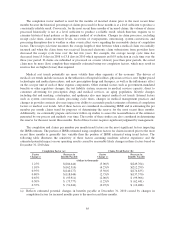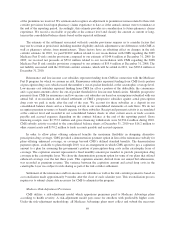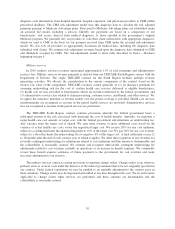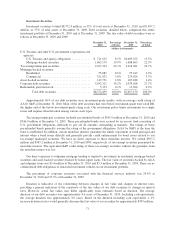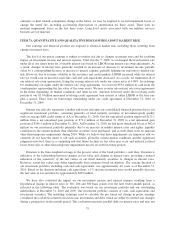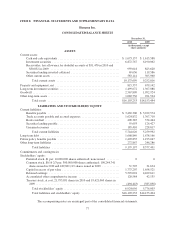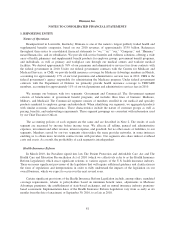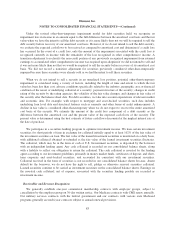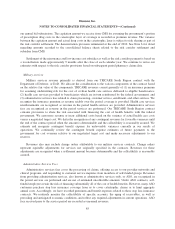Humana 2010 Annual Report Download - page 85
Download and view the complete annual report
Please find page 85 of the 2010 Humana annual report below. You can navigate through the pages in the report by either clicking on the pages listed below, or by using the keyword search tool below to find specific information within the annual report.estimates or their related assumptions change in the future, we may be required to record impairment losses or
change the useful life, including accelerating depreciation or amortization for these assets. There were no
material impairment losses in the last three years. Long-lived assets associated with our military services
business are not material.
ITEM 7A. QUANTITATIVE AND QUALITATIVE DISCLOSURES ABOUT MARKET RISK
Our earnings and financial position are exposed to financial market risk, including those resulting from
changes in interest rates.
The level of our pretax earnings is subject to market risk due to changes in interest rates and the resulting
impact on investment income and interest expense. Until October 7, 2008, we exchanged the fixed interest rate
under all of our senior notes for a variable interest rate based on LIBOR using interest rate swap agreements. As
a result, changes in interest rates generally resulted in an increase or decrease to investment income partially
offset by a corresponding decrease or increase to interest expense, partially hedging our exposure to interest rate
risk. However, due to extreme volatility in the securities and credit markets, LIBOR increased while the interest
rate we would earn on invested assets like cash and cash equivalents decreased. As a result, we terminated all of
our interest rate swap agreements, fixing the average interest rate under our senior notes at 6.08%. In exchange
for terminating our rights under the interest rate swap agreements, we received $93.0 million in cash from the
counterparties representing the fair value of the swap assets. We may re-enter into interest rate swap agreements
in the future depending on market conditions and other factors. Amounts borrowed under the revolving credit
portion of our $1.0 billion unsecured revolving credit agreement bear interest at either LIBOR or the base rate
plus a spread. There were no borrowings outstanding under our credit agreement at December 31, 2010 or
December 31, 2009.
Interest rate risk also represents a market risk factor affecting our consolidated financial position due to our
significant investment portfolio, consisting primarily of fixed maturity securities of investment-grade quality
with an average S&P credit rating of AA at December 31, 2010. Our net unrealized position improved $125.1
million from a net unrealized gain position of $71.4 million at December 31, 2009 to a net unrealized gain
position of $196.5 million at December 31, 2010. At December 31, 2010, we had gross unrealized losses of $62.0
million on our investment portfolio primarily due to an increase in market interest rates and tighter liquidity
conditions in the current markets than when the securities were purchased, and as such, there were no material
other-than-temporary impairments during 2010. While we believe that these impairments are temporary and we
currently do not have the intent to sell such securities, given the current market conditions and the significant
judgments involved, there is a continuing risk that future declines in fair value may occur and material realized
losses from sales or other-than-temporary impairments may be recorded in future periods.
Duration is the time-weighted average of the present value of the bond portfolio’s cash flow. Duration is
indicative of the relationship between changes in fair value and changes in interest rates, providing a general
indication of the sensitivity of the fair values of our fixed maturity securities to changes in interest rates.
However, actual fair values may differ significantly from estimates based on duration. The average duration of
our investment portfolio, including cash and cash equivalents, was approximately 4.0 years as of December 31,
2010. Based on the duration including cash equivalents, a 1% increase in interest rates would generally decrease
the fair value of our securities by approximately $395 million.
We have also evaluated the impact on our investment income and interest expense resulting from a
hypothetical change in interest rates of 100, 200 and 300 basis points over the next twelve-month period, as
reflected in the following table. The evaluation was based on our investment portfolio and our outstanding
indebtedness at December 31, 2010 and 2009. Our investment portfolio consists of cash, cash equivalents and
investment securities. The modeling technique used to calculate the pro forma net change in pretax earnings
considered the cash flows related to fixed income investments and debt, which are subject to interest rate changes
during a prospective twelve-month period. This evaluation measures parallel shifts in interest rates and may not
75


